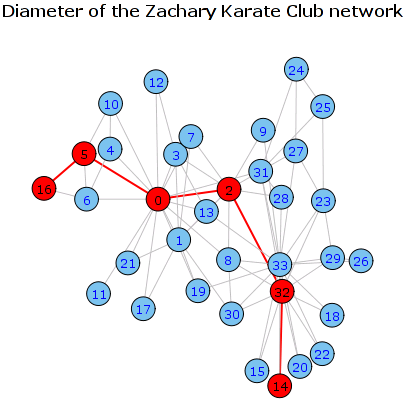Issue: the graph can be very large (millions of nodes!).
It won't be possible to compute the diameter's exact value every time. For instance, running a BFS (Breadth-First-Search) from each node would be too slow...
We will therefore compute an approximate value, and more precisely a lower bound. This was discussed during the course, but ask again if you didn't understand.
I recommend that you simply re-use the BFS implementation done in the previous session (TD1): it's bundled in the test archive test.tar.gz.
-
In the file diam1.cc, finish writing the function DiametreLB() described in file diam1.h:
⚠ I'm providing excellent boilerplate for the .cc, with the "Time Limit" all written for you. Use it! ⚠
Test:#ifndef __DIAM1_H #define __DIAM1_H #include <utility> #include "ugraph.h" using namespace std; // Given a graph, this function tries to find two nodes whose distance // to each other is the as large as possible (the "distance" between two // nodes is the length of the shortest path between them). // // This will represent a lower bound of the diameter. // // WARNING: // Your algorithm will have to run within a given maximum time: // Tmax = 50ms + (M+N)*1µs, where M is the number of edges and N the // number of nodes. This corresponds to O(M+N) complexity. // // For example, if M = 10M (10 millions), N = 1M (1million), Tmax = 11.05s. // // Then, the score you'll get will solely depend on the diameter your // program finds for the various test graphs: the greater the lower bound, // the better the score. // But if you exceed the time limit (on my test machine!), your score // will be zero: keep a safe margin! pair<int, int> DiametreLB(const UndirectedGraph& graph); #endif // __DIAM1_Hrm test.tar.gz; wget --no-cache http://fabien.viger.free.fr/oc/td5/test.tar.gz tar xf test.tar.gz make diam1
TO SUBMIT: diam1.cc
-
Implement in a file diam2.cc the function DiametreUB() described in file diam2.h:
Test: make diam2#ifndef __DIAM2_H #define __DIAM2_H #include <vector> #include "ugraph.h" using namespace std; // Given an undirected unweighted graph, this function returns either: // - a "central" node (so, a vector<int> with a single element) // that minimizes the "radius" of the graph for that center: the // "radius" is the largest distance from the center to any other node. // - a "central" sub-clique, i.e. a subset of nodes that are pairwise // directly connected by an edge, and such that the "radius" is minimal // for that "multi-center" (if that's unclear, ask me). // // In both cases, one can deduce an upper bound of the graph diameter: // - if we returned a single node, with radius R: Diameter <= 2*R // - if we returned a subclique, with radius R: Diameter <= 2*R+1 // // To start simple, you can start by always returning a single node. // The next improvement step should be to either return a single node, // or an edge (which is a subclique of size 2). // Then, you may try to further improve by returning larger sub-cliques // when it helps. // // WARNING: // Same time limit as the previous exercise. // The score will this time be based on the upper bound of the diameter // that can be deduced from your "center": the smaller the radius, the // better the diameter upper bound, and the better the score. vector<int> DiametreUB(const UndirectedGraph& graph); #endif // __DIAM2_H
TO SUBMIT: diam2.cc
